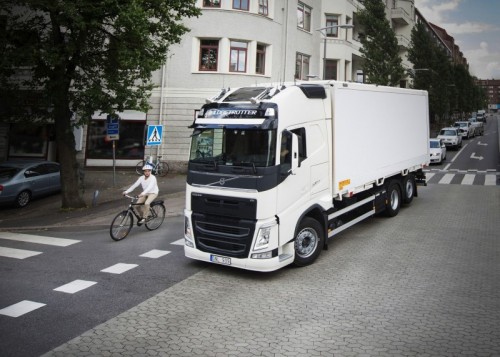
“In the 2017 Volvo Trucks Safety Report we analyse and describe why accidents involving trucks occur, how they happen, and what should be done to reduce the risk of accidents and their consequences. These are facts that are not only important to our own product development but also to everyone who works for a safer traffic environment,” says Peter Wells, head of the Volvo Trucks Accident Research Team.
The 2017 Volvo Trucks Safety Report is based on Volvo’s own accident investigations and on data from various national and European authorities. One of the report’s conclusions is that there is a greater need to focus on reducing risks for vulnerable road users such as pedestrians, cyclists, moped riders and motorcyclists.
“In the past decade the number of serious road accidents involving heavy trucks has been almost halved in Europe. However, truck accidents involving vulnerable road users have not been reduced to the same extent,” says Carl Johan Almqvist, Traffic & Product Safety Director at Volvo Trucks.
About 35 per cent of people suffering serious injuries or fatalities in accidents involving heavy trucks are vulnerable road users. With the increasing pace of urbanisation and with more people and vehicles on the roads, there is a risk that injuries will increase unless serious action is taken.
“In order to cut accident rates it is necessary to continue the development of a number of technical solutions that can help the truck driver avoid potentially hazardous situations. Moreover, all road users need to become more aware of the risks that exist in the traffic environment and how we can best reduce them,” explains Carl Johan Almqvist.
Vulnerable road-users are in focus in the 2017 Volvo Trucks Safety Report.
The seat belt is still the single most important safety equipment.
Carl Johan Almqvist, Traffic & Product Safety Director.
Peter Wells, head of Volvo Trucks’ Accidents Research Team.
Giving the driver a clear overview of the truck’s immediate vicinity is crucial to accident prevention. As one of many complements to rear-view mirrors, close-quarter mirrors and reversing cameras, Volvo has a solution whereby the driver can see what is happening in the front corner of the passenger side with the help of a camera.
“It is also important for pedestrians and cyclists to be aware of the importance to see and be seen and to assist in smooth, safe interaction in traffic. That’s why we are directing our educational material to both youngsters and adults, for instance our Stop, Look, Wave and See and Be Seen campaigns, which spotlight precisely these issues,” says Carl Johan Almqvist.
In order to reduce the risk of accidents with other vehicles, Volvo’s trucks are equipped with various active safety systems. But if an accident does occur, it is a tried and trusted part of the safety equipment that is the most important life-saver – the seat belt.
“The report reveals that far too many truck drivers don´t use their seat belts even though we know that half of the unbelted truck drivers who have died in road accidents would have survived, had they been wearing their seat belts,” says Carl Johan Almqvist.
The 2017 Volvo Trucks Safety Report is the second externally published report from Volvo Trucks’ Accident Research Team.
“Cutting road accidents is an immensely important global issue. That’s why we want to share our research results in a clear and easy to understand way,” says Peter Wells.
The 2017 Volvo Trucks Safety Report can be found in its entirety at volvotrucks.com and Volvo Truck Parts can be found at www.swedishtruckpartsshop.co.uk/volvo-parts-9-c.asp
Facts about the Volvo Trucks Accident Research Team (ART)
ART has investigated and analysed road accidents involving trucks since 1969. For almost 50 years now ART’s experience and expertise have formed the cornerstone of Volvo Trucks’ drive to continuously improve its vehicles’ accident-prevention and injury-prevention properties, making Volvo’s trucks among the safest on the market.
